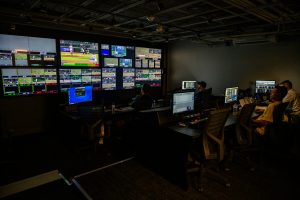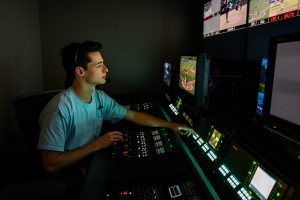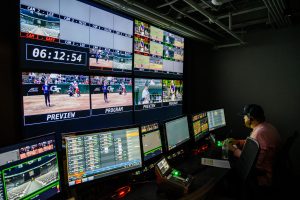Georgia Tech Turns Production Facility Into an ACC Network Fortress
The new structure comprises three control rooms and 864 strands of fiber
Story Highlights
The Georgia Institute of Technology, or simply Georgia Tech, is known mostly for developing the world’s next great wave of biomedical and industrial engineers. As one of the best research universities in the nation, the Yellow Jackets know a little something about hard work. With today’s official launch of the ACC Network, the institute gave a new meaning to “Tech” by renovating its 6,400-sq.-ft. on-campus production facility to a tune of $10 million.
“[Georgia Tech] is a really cool place to be as far as how it relates to sports and sports recruiting,” says Andy Blanton, assistant athletic director, video and broadcast services, Georgia Tech. “I’ve seen a lot of our teams use this facility as part of a recruit visit and show student athletes who might be interested in doing this just to show it off and allow them to get geeked up about the opportunity to either be showcased through this facility or have some sort of role inside of this facility. Right now, it’s a shiny new toy, and everybody really appreciates what it is, and it has helped us recruit folks in many different ways and forms.”
Building a New Beast: Georgia Tech Reaches Out to a Duo of Integrators
Like many great ideas throughout history, the start of a project generates a spark for others that will be created in the future. Sometimes, projects need a little nudge to get them into motion. When ESPN created its partnership with another prominent collegiate conference, Blanton began planning his masterpiece before the concept of an ACC Network had a stable floor. As with many of his cohorts, the team leveraged the advice offered by those who had gone before.
“Conceptually, we started thinking about this along the same time that the SEC Network was starting to get off the ground [around 2013] ,” says Blanton. “We started paying very close attention to what the SEC schools were being asked to do. A lot of the [staffers at the] ACC schools converse with their counterparts at an SEC school that might be their rival. In our case, I talked a lot with the University of Georgia and Auburn University.”
When the ACC Network platform got the blessing of the ESPN in 2016, Blanton went full steam ahead to start the necessary procedure for a renovation. After filing paperwork for an estimated $10 million budget with the University System of Georgia’s Board of Regents, his team began efforts to choose a consultant.
“On July 18, [2018,] we were meeting with architects to design the building, design the footprint of the control rooms, and all of the fiber infrastructure on campus,” he says. “Then, we had the local group here in town, CTG [Comprehensive Technical Group], come alongside us in the beginning to do some consulting on what this project would look like financially.”
Months later, on Sept. 10, Alpha Video was given the opportunity to lead the charge on the new initiative. With the help of Brian Beckwith, broadcast design engineer, Alpha Video, the two parties created a blueprint while the system integrator started constructing sets in Nashville. Around the holiday season in 2018, Alpha Video came on campus poised to complete the task.
“[Working with Georgia Tech] was important because we have a strong presence in the area with the Atlanta Braves and some of the other folks in the area like the College Football Hall of Fame,” says Jeff Volk, VP, Alpha Video. ”For us, it was a great extension of not only the partners and clients that we have in the region but someone that we’ve identified that we’d wanted to work with for a long time.”
The Aches and Pains: Finding Even Ground in Uncharted Territory
Despite a constant flow of tips and guidance from folks in the Southeastern Conference, the effort was easier said than done. Although a $10 million budget was approved, Blanton and the team at Alpha Video needed to find a balance between shooting for the stars and coming in below the allotted dollar amount.
“We needed to work with them in order to align the equipment list and the final system design to their budget,” says Volk. “At first, they were over budget, so we worked with them over a period to finalize their costs. We also included some onsite equipment demos with several camera vendors and replay-system demos. There was certainly some give and take, but, in the end, I think we more than delivered on all of their must-have items.”
Also, a steady flow of productions doesn’t stop with a new buildout. Blanton and Georgia Tech’s staff of six full-time employees and eight student interns needed to devise a daily agenda to juggle a busy spring sports schedule.
“The biggest challenge was just time management to stay on top of all of this in the busiest time of the year,” says Blanton. “We didn’t really plan to start and end when we did; we just moved forward as the university channels allowed us to. The physical construction of the building dictated when the equipment and technological elements could come into play. In parallel with the building being constructed, you’ve got all other things to do, like picking out carpet and wall color, [from] types of lights to furniture and office layouts. It was very difficult to manage [more than] 90 productions that we were already doing out of our single control room while doing this major construction project.”
In addition to the growing pains of construction, the increased influx of content generated by a new facility can be stressful as well.
“There’s a massive thought process that went into [this project],” says Blanton. “How many of what do we need and why? How many simultaneous events are we going to have, and how many control rooms are we going to need? How many cameras are we going to need? And, at the end of the day, how much gear does that mean we’re moving around? We definitely wanted to make sure that we had everything that we needed.”
A Campus-Wide Link: Three Control Rooms, Bundles of Fiber Link Venues
At the corner of Fowler and 8th Streets, the revamped facility houses a wealth of technology, fiber infrastructure, and production toys to handle a full season’s worth of Georgia Tech college athletics. Ross Video provided Carbonite Black production switchers and XPression graphics packages for Control Rooms A (CR-A), B (CR-B), and C (CR-C). Yamaha was chosen for audio gear, supplying a CL5 console in CR-A and a CL3 in each of the other two spaces. In the replay suite, Evertz supplied multiple DreamCatcher machines with 36 inputs and 18 outputs; its EQX router is controlling the facility off of baseband. For constant chatter and collaboration, Riedel Communications’ intercom system has been implemented.
For a wide range of productions, Blanton purchased 13 Panasonic AK-HC5000GSJ hard cameras and six Marshall CV345-CSB’s for ancillary purposes. The Panasonic cameras can be outfitted with either five 80X or two 24X HD zoom lenses from Canon.
As for fiber, the hub-and-spoke approach starts with 864 strands from the new facility to many venues across the Georgia Tech property: Bobby Dodd Stadium (football), Russ Chandler Stadium (baseball), Shirley Clements Mewborn Field (softball), Byers Tennis Complex, O’Keefe Gymnasium (women’s volleyball), the McAuley Aquatics Center (swimming and diving), and some other buildings on campus.
“We actually added fiber infrastructure to our indoor [John and Mary Brock Football Practice Facility] for things like Pro Day and any other live events that we would want to do from there,” Blanton says. “We’re unique because we don’t have soccer, lacrosse, wrestling, or gymnastics, so those sports don’t apply to us. Also, [fiber to those] venues [is] broken up in different quantities: there may be 48 strands that went to this particular venue, 96 to another, and so forth. It all depends on the need of the venue for our purposes.”
Despite the new facility’s invigorating spirit, the institution still uses the place the production team used to call home. The McCamish Pavilion, which is across from the broadcast building, can still be used for specific events.
“When you’re having [men’s and women’s] basketball events, [the old control room] would be the room that you would do your basketball-videoboard production from because it just makes sense,” says Blanton. “It’s easier to be in the venue, and we anticipate a lot of linear productions to have to sidecar with basketball games. Those linear productions will function from the control room out of the new building, and then, it’s a lot like the traditional model, where there’s a TV truck outside. It’s going to marry up quite nicely.”
An Interchangeable Solution: Proper Staffing, Multivenue Mindset Combat Hectic Schedule
Blanton’s crew may not be as big as others, but its members get the job done in an efficient way. With today’s launch, he expects some additional help with new job openings.
“We’re trying to grow [our employee count] as quickly as possible,” he says. “We have space to open that up to around 20 or so, and those students could get an average of 20 hours a week. We’re looking to fill those people in on various positions from camera to graphics, to shading, to replay, or whatever we can put them on.”
The forward-thinking duo of Alpha Video and Blanton developed a system that could add the old control room online along with the new one. In a busy college schedule, having a flexible answer is needed.
“We renovated the old control room to have KVM access,” Blanton explains. “If I need to route any camera to any place, we created that flexibility. We designed this facility for our sport count and how many games that we would have going on simultaneously and then how many times we would have to move by sport or by season. If I’ve done my homework right, we will designate a control room to a [single] sport for an entire season and not have to reroute or redo anything for that sport for that whole season. When that season completes, the sport that occupied [the space] gets changed over to another facility, and [the space] becomes the next control room for that entire season. The [only time] you’re having to reroute or change things is when sports seasons begin and end. That’s how we designed the workflow.”
Pre-Launch Prep: Crews Put in Springtime Reps
The broadcast-control rooms were all synced and ready to roll by March 3, just in time for Georgia Tech softball vs. Western Carolina. The first broadcast out of the facility marked the beginning of the institution’s pre-launch preparation tour.
“We had a nice head start on the summer, which allowed us to sit back a little bit and go, ‘Okay, here’s what we learned from just a little bit of production from March, April, May, June, [when] we were able to get in there and start to put our hands on things,’” says Blanton. “Going into this upcoming fall, we made some adjustments to how things work to make our lives easier. But, all in all, I think we’re in good shape.”
Volk and his Alpha Video staff have continued to provide a wealth of knowledge throughout the transition.
“We’ve had a team of four or five people down there for the last several weeks to finalize and get everything ready to go for the launch,” he says. “We’ll have some onsite staff for the first couple of events. We also are actually implementing a bunch of changes from things that we had initially thought that this is how we would want it. One of the advantages of being able to use the system in the spring was that we figured out some things that [Blanton] and ESPN wanted a little bit differently for linear productions.”
Although Blanton has been able to take his new wheels out for a spin, he expects the volume of programming to be similar to that in the previous year.
“I think we’re going to try to stick around that 100 number, but we’re going to try to do as many as possible,” he explains. “We don’t really have a specific number that we’re going to cap at since it’s going to be dependent on schedules’ getting released. Which events are overlapping with other events, when are we asked to do linear games, and what does that look like staffing-wise?”
The first production of the season will air on Sept. 29, the day of the inaugural ACC Network voyage with volleyball vs. Boston College.
A Shift in Identity: The Program’s Effort in Redefining the Culture
Today is the day when the lid of the cookie jar is taken off and consumers can enjoy its contents. One of the people who has worked tirelessly on the buildout is thoroughly pleased with the outcome.
“I think [Blanton] has a beautiful facility that is one of, if not the best in the ACC,” says Volk. “I think he was one of the later folks to get his facility budgeted and built. When you’re the last, you have the ability to learn from the things that other people have done and the things that they like and don’t like. Andy has a good relationship and maintains a good relationship with the guys in the ACC, so he had asked a lot of questions along the way of his peers in the conference. From the control-room side of things, we’re very proud of what we got done there.”
With pride, success, and other intangible variables, Georgia Tech’s broadcast efforts now have a backbone that can create pipelines to nearby Turner Sports and potentially erase the stigma of performing well solely in engineering.
“It’s interesting because Georgia Tech is a very technical place,” Blanton says. “I oftentimes use the analogy that the students are launching spaceships into space and are not always as focused on making television broadcasts. We don’t have a broadcast and communications or mass-communications major here, so we just put an open-ended invitation out there for folks here on campus and to some of the other nearby colleges like Georgia State and Kennesaw State. In addition, we started working on plans to invite the local high schools to come through and tour our facility and get exposure to what goes on here, because a lot of the local high schools are doing some pretty good production and broadcast work.”
CLICK HERE to check out more SVG coverage of ACC Network Launch Day.




